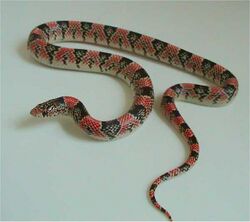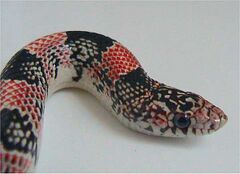Biology:Long-nosed snake
| Long-nosed snake | |
|---|---|

| |
| Texas long-nosed snake Rhinocheilus lecontei tessellatus | |
| Scientific classification | |
| Domain: | Eukaryota |
| Kingdom: | Animalia |
| Phylum: | Chordata |
| Class: | Reptilia |
| Order: | Squamata |
| Suborder: | Serpentes |
| Family: | Colubridae |
| Genus: | Rhinocheilus |
| Species: | R. lecontei
|
| Binomial name | |
| Rhinocheilus lecontei Baird & Girard, 1853
| |
| Synonyms | |
The long-nosed snake (Rhinocheilus lecontei) is a species of nonvenomous snake in the family Colubridae. The species is endemic to North America. It has two recognized subspecies. The other species in the genus were previously considered subspecies. [citation needed]
Etymology
The specific name, lecontei, commemorates American entomologist John Lawrence Le Conte (1825-1883).[5]
Description
The long-nosed snake is distinguished by a long, slightly upturned snout, which is the origin of its common name. It is tricolor, vaguely resembling a coral snake, with black and red saddling on a yellow or cream-colored background. Cream-colored spots within the black saddles are a distinct characteristic of the long-nosed snake. It differs from all other harmless snakes in the United States by having undivided subcaudal scales.[6] The total length (including tail) of adults is usually 22–32 in (56–81 cm), but the maximum record total length is 41 in (100 cm).[7]
Behavior
R. lecontei is a shy, nocturnal burrowing snake. It spends most of its time buried underground.[citation needed]
Diet
The long-nosed snake feeds on lizards, amphibians, and sometimes smaller snakes and infrequently rodents.[citation needed]
Reproduction
R. lecontei is oviparous,[8] laying clutches of 4-9 eggs in the early summer, which hatch in the late summer or early fall.[citation needed]
Defense
The long-nosed snake is not apt to bite, but will release a foul smelling musk and blood[9] from the cloaca as a defense mechanism if harassed.
Habitat
The preferred natural habitats of the long-nosed snake are desert, grassland, shrubland, and savanna.[1]
Geographic range
R. lecontei is found in northern Mexico from San Luis Potosí to Chihuahua, and into the southwestern United States, in California , Nevada, Utah, Idaho, Arizona, New Mexico, southeastern Colorado, southwestern Kansas ,[8] Oklahoma,[10] and Texas .[8]
Subspecies
- Western long-nosed snake, Rhinocheilus lecontei lecontei Baird & Girard, 1853
- Texas long-nosed snake, Rhinocheilus lecontei tessellatus Garman, 1883
In captivity
The long-nosed snake is not often found in the exotic pet trade as it frequently rejects rodent-based diets that are most readily available for captive snakes.[citation needed]
References
- ↑ 1.0 1.1 Hammerson GA, Frost DR, Santos-Barrera G (2007). "Rhinocheilus lecontei ". The IUCN Red List of Threatened Species 2007: https://dx.doi.org/10.1305/IUCN.UK.2007.RLTS.T63909A12725667.en. Accessed on 02 March 2022.
- ↑ Cope ED (1866). "On the REPTILIA and BATRACHIA of the Sonoran Province of the Nearctic Region". Proceedings of the Academy of Natural Sciences of Philadelphia. "1866" [18]: 300-314. ("Rhinochilus [sic] lecontei ", p. 304).
- ↑ Boulenger GA (1894). Catalogue of the Snakes in the British Museum (Natural History). Volume II., Containing the Conclusion of the Colubridæ Aglyphæ. London: Trustees of the British Museum (Natural History). (Taylor and Francis, printers). xi + 382 pp. + Plates I-XX. ("Rhinochilus [sic] lecontii ", pp. 212-213).
- ↑ Stejneger L, Barbour T (1917). A Check List of North American Amphibians and Reptiles. Cambridge, Massachusetts: Harvard University Press. 125 pp. (Rhinocheilus lecontei, p. 91).
- ↑ Beolens, Bo; Watkins, Michael; Grayson, Michael (2011). The Eponym Dictionary of Reptiles. Baltimore: Johns Hopkins University Press. xiii + 296 pp. ISBN:978-1-4214-0135-5. (Rhinocheilus lecontei, p. 154).
- ↑ Schmidt KP, Davis DD (1941). Field Book of Snakes of the United States and Canada. New York: G.P. Putnam's Sons. 365 pp. (Rhinocheilus lecontei, pp. 194-196, Figure 61 + Plate 21).
- ↑ Powell R, Conant R, Collins JT (2016).
- ↑ 8.0 8.1 8.2 Species Rhinocheilus lecontei at The Reptile Database www.reptile-database.org.
- ↑ McCoy CJ Jr, Bianculli AV (1966). "Defensive behavior of Rhinocheilus lecontei ". Journal of the Ohio Herpetological Society 5 (4): 166.
- ↑ T. Robyn captured, identified, and released one near Lawton, Oklahoma, 2010.
External links
- USGS: Rhinocheilus lecontei
- "IUCN Red List of Threatened Species". http://www.iucnredlist.org/search/details.php/63909/summ.
- WhoZoo: Long-nosed Snake
- NatureServe Explorer: w/ 2 RangeMaps: Rhinocheilus lecontei. Click "DISTRIBUTION" for maps.
Further reading
- Baird SF, Girard C (1853). Catalogue of North American Reptiles in the Museum of the Smithsonian Institution. Part I.—Serpents. Washington, District of Columbia: Smithsonian Institution. xvi + 172 pp. (Rhinocheilus, new genus, p. 120; R. lecontei, new species, pp. 120–121).
- Behler JL, King FW (1979). The Audubon Society Field Guide to North American Reptiles and Amphibians. New York: Alfred A. Knopf. 743 pp. ISBN:0-394-50824-6. (Rhinocheilus lecontei, pp. 649-650 + Plates 593, 609).
- Conant, Roger, Bridges, William (1939). What Snake Is That? A Field Guide to the Snakes of the United States East of the Rocky Mountains. (With 108 drawings by Edmond Malnate). New York and London: D. Appleton-Century Company. Frontispiece map + viii + 163 pp. + Plates A-C, 1-32. (Rhinocheilus lecontei, p. 86 + Plate 14, Figure 41).
- Powell R, Conant R, Collins JT (2016). Peterson Field Guide to Reptiles and Amphibians of Eastern and Central North America, Fourth Edition. Boston and New York: Houghton Mifflin Harcourt. xiv + 494 pp., 47 plates, 207 figures. ISBN:978-0-544-12997-9. (Rhinocheilus lecontei, pp. 392-393 + Plate 37).
- Smith HM, Brodie ED Jr (1982). Reptiles of North America: A Guide to Field Identification. New York: Golden Press. 240 pp. ISBN:0-307-13666-3 (paperback). (Rhinocheilus lecontei, pp. 164–165).
- Stebbins RC (2003). A Field Guide to Western Reptiles and Amphibians, Third Edition. The Peterson Field Guide Series ®. Boston and New York: Houghton Mifflin Company. xiii + 533 pp. ISBN:0-395-98272-3 (paperback). (Rhinocheilus lecontei, pp. 370–371 + Plate 44 + Map 155).
- Wright AH, Wright AA (1957). Handbook of Snakes of the United States and Canada. Ithaca and London: Comstock Publishing Associates, a Division of Cornell University Press. 1,105 pp. (in 2 volumes) (Genus Rhinocheilus, p. 630-633 + Figure 19 on p. 69). (species Rhinocheilus lecontei, pp. 633–644, Figures 183-187, Map 48).
- Zim HS, Smith HM (1956). Reptiles and Amphibians: A Guide to Familiar American Species: A Golden Nature Guide. Revised Edition. New York: Simon and Schuster. 160 pp. ("LONG-NOSED SNAKE", Rhinocheilus lecontei, pp. 101, 156).
Wikidata ☰ Q2021215 entry
 |



